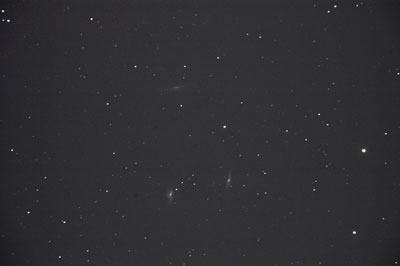This distinctive constellation has been identified with a lion for over 5,000 years. To modern amateur astronomers it is known primarily for its galaxies. The lion is also the home of the third nearest neighbor star of the Sun, the about Jupiter-sized dwarf star Wolf 359. It is only 7.6 light-years away and with 13.5m not an easy target even for telescopes – it remains unobservable in binoculars. Wolf 359 is located a little more than 2° west of the 4.6m star χ Leonis.
α Leonis (Regulus) is the 1.4m bright main star of Leo and only 77.5 light-years away. In binoculars you can see its 8.1m bright companion in three minutes of arc distance. It has approximately the same distance as Regulus, but it is likely to be only an optical double star.
When Hipparchus compared the positions of Regulus and Spica in 130 A.D. to Babylonian descriptions from 200 years before, he discovered the precession of Earth‘s axis due to the changed position of the star. The name Regulus (Little King) goes back to Nicolaus Copernicus. Before him, the star was known as Cor Leonis (Heart of the Lions) or referred to as „royal star“. In Babylonian times it was called „Amil-galur“, the „Ruler before the Flood“.
R Leonis is a Mira-type variable at a distance of 330 light-years, which was first observed in 1782 by J.A. Koch in Gdansk. Within an average of 312.4 days its brightness varies between 5.4 and 10.5m. The star shows a distinct red color during the maxima.
M 65, M 66 and NGC 3628 form a beautiful group of galaxies between θ and ι Leonis. The center of the 9.7m bright M 66 is the easiest target. Under optimal conditions, you can imagine the faint glimmer of the spiral arms already in 10×50s with averted vision. Photographs show clearly that the 32 million light-years distant galaxy contains a lot of dust. M 65 is similar to M 66, but at 10.1m it‘s fainter. M 65 is 21 arc minutes to the west of M 66 and 56 million light-years away. Both galaxies are about nine arc minutes in width and four arc minutes in depth.
0.5° north of the two galaxies, you may find the weak shimmer of the at least 4 × 14 arc minutes wide edge-on galaxy NGC 3628. Because of its size, the 10.4m bright galaxy is visible only under very good conditions in a pair of 10 × 50 binoculars, otherwise you need giant binoculars or better yet a telescope.

The second famous group of galaxies in Leo consists of M 95, M 96 and M 105. The brightest member of the group is 47 million light-years distant M 96 at 9.2m. It can be found close to the connecting line between θ and ρ Leonis. M 95 is 42 arc minutes away from it and a 10.6m bright barred spiral galaxy.
Both galaxies have a diameter of about seven minutes of arc. The bar of M 95 can be seen only in a telescope, then also a ring around the galaxy becomes visible, so that it reminds of the Greek letter Θ. 1° north of M 96 is the 36 million light-years distant elliptical galaxy M 105. It has a diameter of 35,000 light-years and appears as a bright 9.3m. There is a ring of gas inside of M 105 which rotates independently of the rotation of the galaxy. You need at least 10x or 15x magnification to see more of these galaxies than the core as a fuzzy star – averted vision facilitates the observation.
